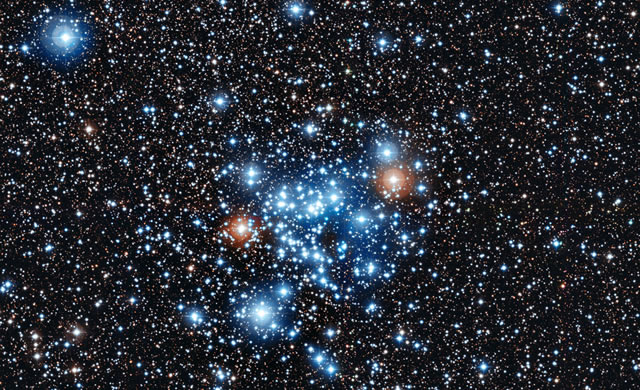
Credit: ESO
Minuscole variazioni di luminosità rivelano una nuova categoria di stelle – Alcuni astronomi hanno trovato, con il telescopio svizzero Eulero da 1,2 metri di diametro all’Osservatorio di La Silla dell’ESO in Cile, un nuovo tipo di stella con pulsazioni. La scoperta si basa sull’individuazione di minuscole variazioni di luminosità di alcune stelle nell’ammasso. Le osservazioni hanno rivelato alcune proprietà di queste stelle precedentemente sconosciute che sfidando le teorie correnti e pongono interessanti domande sull’orgine della variabilità.
Gli svizzeri sono giustamente famosi per la loro maestria nel creare componenti tecnologiche molto precise. Ora un’equipe svizzera, dell’Osservatorio di Ginevra, ha raggiunto una precisione straordinaria usando un telescopio relativamente piccolo, da 1,2 metri di diametro, per un programma osservativo che dura da molti anni: hanno scoperto una nuova classe di stelle variabili misurando minuscole variazioni della luminosità delle stelle. I nuovi risultati si basano su misure regolari della luminosità di più di tremila stelle nell’ammasso stellare aperto NGC 3766 su un periodo di almeno sette anni. Queste misure rivelano come almeno 36 stelle dell’ammasso seguano un modello inaspettato – presentano variazioni di brillanza regolari, a livelli dello 0,1% del normale valore di luminosità. Queste variazioni hanno periodi di circa 2 e 20 ore. Le stelle sono un po’ più calde e più luminose del Sole, ma per il resto apparentemente insignificanti. La nuova classe di stelle variabili deve ancora ricevere un nome ufficiale. Questo livello di precisione nelle misure è due volte meglio di quello ottenuto da studi analoghi con altri telescopi – e sufficiente per scoprire per la prima volta queste minuscole variazioni.
Fonte/Leggi tutto → ESO.org
Minute variations in brightness reveal whole new class of stars – Astronomers using the Swiss 1.2-metre Euler telescope at ESO’s La Silla Observatory in Chile have found a new type of variable star. The discovery was based on the detection of very tiny changes in brightness of stars in a cluster. The observations revealed previously unknown properties of these stars that defy current theories and raise questions about the origin of the variations.
The Swiss are justly famed for their craftsmanship when creating extremely precise pieces of technology. Now a Swiss team from the Geneva Observatory has achieved extraordinary precision using a comparatively small 1.2-metre telescope for an observing programme stretching over many years. They have discovered a new class of variable stars by measuring minute variations in stellar brightness. The new results are based on regular measurements of the brightness of more than three thousand stars in the open star cluster NGC 3766 over a period of seven years. They reveal how 36 of the cluster’s stars followed an unexpected pattern — they had tiny regular variations in their brightness at the level of 0.1% of the stars’ normal brightness. These variations had periods between about two and 20 hours. The stars are somewhat hotter and brighter than the Sun, but otherwise apparently unremarkable. The new class of variable stars is yet to be given a name. This level of precision in the measurements is twice as good as that achieved by comparable studies from other telescopes — and sufficient to reveal these tiny variations for the first time.
Source/Continue reading → ESO.org





















